The Dragon Quest franchise was once merely an RPG series, but it has really started to branch out in recent years with spinoffs like Dragon Quest Builders and Dragon Quest Heroes. The latter was a musou style game that was developed by Omega Force, an expert in that genre. After the success of that game, a followup was a foregone conclusion and now it has arrived with Dragon Quest Heroes 2.
Rather than build upon the story of the first game, Dragon Quest Heroes 2 takes note from most of the rest of the series and is yet another standalone entry. At the start, you can pick between either a male or female protagonist that are named Lazarel and Teresa by default. These two are cousins and if you pick one, the other will then be part of your party as well.
Dragon Quest Heroes 2 takes place in a world of seven different kingdoms that has been peaceful for ages, but all of a sudden end up at war, with you right in the middle of it. The story isn’t anything spectacular, but it’s more than serviceable at being able to keep you interested between the battles.
The cutscenes especially showcase the gorgeous art style and visuals found in Dragon Quest Heroes 2, which also translate over to the battlefield as well. Dragon Quest has always been a bright and colorful series and that really shines throughout the game here alongside the memorable soundtrack, which mixes perfectly with the game’s witty and joyous charm.

The combat in Dragon Quest Heroes 2 is mostly what you would expect from such a game, with you having two basic attacks by pressing Square or Triangle, as well as special attacks that can be accessed by holding down R1 and then pressing a corresponding face button. While you have a fairly easy to learn control scheme regardless, you can choose between quick controls or slick controls. Musou games are very much built for button mashing, though they can get very difficult at times anyways. The quick controls are the simplest style, where you can get strong combos and attacks, while slick controls require much more precision in what type of attack you are using and the timing of said attacks.
Players have the ability to control a party of four members in Dragon Quest Heroes 2. You can only control one at a time, but by pressing L2, you can switch to the next character in your lineup. You can even use a special tag attack here at well, which can be very useful after bosses. It is rather annoying that you can only rotate through your party in one direction, meaning you have to go from one through four in order before you can return back to four. With how often you’ll be switching, it would have been much better to have had this option added this time, though this and the combat as a whole manage to feel incredibly smooth even in the midst of a major fight with enemies everywhere.
Many of the battles in the game are quite difficult and require you to harness further abilities, which you happen to have at your disposal. The powered up Tension state returns, which can be reached by filling up the Tension meter in battle. When Tension is active, you do not use any MP while performing abilities and also get an ultimate attack that can deal massive damage. Unleashing each of these in a row can be a lot of fun and is a great strategy to use in battle.
The first Dragon Quest Heroes implemented a Monster Medal system, which is back again with a big change. Monster Medals are dropped occasionally by enemies and if collected, you can summon them onto the battlefield to help. Previously, certain monsters could be summoned and some would only perform one super attack and disappear. However, now you will get Monster Medal drops from some of the stronger enemies that are known as Substitute Monster Medals. When these are summoned, they will actually take the place of your selected character and let you control them entirely for a short duration of time.

One of the downfalls of most any musou style game is that the gameplay can get pretty repetitive after awhile, but Dragon Quest Heroes 2 manages to avoid this most of the time due to the mixed gameplay that falls somewhere between Dynasty Warriors and Dragon Quest, along with a large cast of playable characters. The character roster in the game is rather impressive, much like the first game, which not only introduces a completely new cast, but also many others from throughout the series.
The character setup is similar to that of the first game, though an issue in that game was the overload of characters from certain games, specifically Dragon Quest IV. Thankfully, this has been improved a good bit in Dragon Quest Heroes 2, with the roster growing in the sequel. On top of the original characters that are new to the game entirely, the roster branches out a little more with a few characters from Dragon Quest VII available, though the fan favorite Yangus sadly didn’t make the cut this time. The only frustrating thing is that you can’t change you party members from the menu, but rather have to visit a specific person in town to do so, even if they are easy to get to at any point of the game.
Each character has a leveling system akin to that of the rest of the franchise, with you gaining experience through battle. At each new level reached, you obtain additional Skill Points that you can spend on that specific character. This is where some strategy comes in, as you can choose to use those Skill Points to unlock new abilities, upgrade your HP, MP, and such, as well as unlock some different boosts that are only for that individual character.

Making it even more in-depth, the game utilizes a class system like Dragon Quest is known for, as well as a proficiency system that goes beyond the skills. In Dragon Quest 8, for instance, these two are combined, but here they are separate. Depending on the weapon type you are using, you will level up your proficiency in each, which are done with star ratings. You can then visit the Martial Master that will unlock special abilities and boosts at these levels, along with what are known as Party Powers. These are learned at every five proficiency levels with a weapon and give you useful boosts that affect the whole party.
Goes back to the roots of the long running Dragon Quest franchise
The first Dragon Quest Heroes game followed a more typical musou game route by having the game mostly split up into missions with little exploration. However, Dragon Quest Heroes 2 goes back to the roots of the long running Dragon Quest franchise by having you actually travel between areas on the map to get back and forth between locations. There is still a mission structure that has you doing one large arena based fight after another for certain areas, but you also get to make you way across this world as well, where you will run across numerous NPCs that may need your help or can help you in some way. This is something that Dragon Quest has always been known for and it’s great to see that RPG aspect return here.
Similar to the mainline games, you have a Zoom ability at your disposal that allows you to teleport from one area to the next. This is done by activating crystals that are found in the overworld, making it possible to then Zoom right there at anytime. Mixing this in with an overworld map to explore helps to make the game feel even more like a Dragon Quest outing than the previous one did.

Another new feature found in Dragon Quest Heroes II is up to four player online cooperative multiplayer. The game offers dungeons that you can take on with a team, as well as solo, which are great leveling tools for your characters. However, that is not the only multiplayer option in the game. If you need help with a story battle, you can find just that online if someone else is willing to do so. This is a great feature that should be very helpful in the more difficult story battles that come during the latter stages of the game.
The Verdict
Dragon Quest Heroes already proved that the musou genre mixed well with this classic RPG series and that formula has returned with a few tweaks to make it even better in Dragon Quest Heroes 2. Moving away from the more strict mission based structure, players now get to travel across the lands of the seven kingdoms in-between the smoother than ever large scale battles. As with any musou game, the combat will get repetitive at times, but there is no question that Dragon Quest Heroes 2 is a bigger and better followup to the original that continues to be a love letter to the Dragon Quest fandom.







